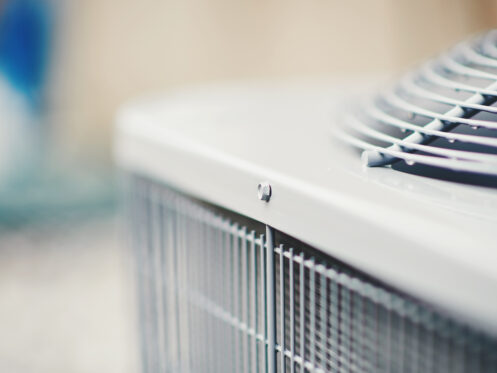There’s nothing worse than expecting a blast of cool air from your AC on a sweltering, hot summer day and getting a warm breeze instead. Your air conditioner spewing warm air is a sign that something is wrong. The good news is that many of these problems can be easily detected and diagnosed. Figuring out the cause of the warm air from the AC unit can help you determine whether you can fix the issue on your own or need to bring in a professional.
At 3 Mountains Home Services in Milwaukie, OR, we pride ourselves on helping our customers with home appliances, including AC units. Read on to learn more about the top eight things to check when your AC starts blowing warm air so you can troubleshoot quickly and stay relaxed and comfortable all summer.
1. Check Thermostat Settings
The thermostat settings are one of the first things you should check if your AC is blowing warm air. Start by ensuring that your thermostat is set to COOL mode, not HEAT or FAN mode. Sometimes, it’s easy to switch it back to COOL, especially if many people are living in the home together. Next, it’s important to ensure the temperature is lower than the ambient room temperature. The AC won’t kick on if it’s set to 70 degrees Fahrenheit but the ambient temperature is 72 degrees Fahrenheit. We also recommend checking the thermostat’s batteries because weak ones can create issues as easily as dead ones. Finally, if you have a smart thermostat, take the time to check the schedule and make sure that it is fully connected to your Wi-Fi system.
2. Inspect Air Filter: Clogs and Blockages
A clogged or dirty air filter is another reason AC air blows hot rather than cool. Trapping dust, debris, and other airborne particles is the goal of your air filter, but when it is dirty, it can’t trap particles in the same way. Debris can block the filter over time and limit airflow, making your AC work harder. If your AC works too hard, the system might overheat and shut off or begin blowing warm air. The best way to fix this issue is to remove and replace the existing filter. Depending on use and manufacturer recommendations, most filters should be replaced every one to three months. Maintaining the cleanliness of your air filter enhances indoor air quality as well as helps your AC function more effectively. A basic but important maintenance chore that can avoid many typical cooling problems is routinely checking and replacing the air filter.
3. Examine the Condenser Coils: May Require Cleaning
Condenser coils are important in your AC system because they help release the heat absorbed from your home to the outside. When the coils are dirty, they can’t release heat, and your AC starts blowing warm air. To check your condenser coils, the power needs to be turned off to your AC system. Then, the protective grilles and panels need to be removed. Check for dirt and debris, such as leaves or grass clippings. It can be cleaned with coil cleaner and a soft brush if they’re dirty. Be careful not to damage the fragile fins as you clean. We recommend hiring a professional for this process!
4. Assess the Refrigerant Levels: Detect Leaks and Refills
The refrigerant is the heartbeat of your air conditioning system, collecting and releasing heat to chill your home. The AC in your home might be blowing warm air due to low refrigerant levels. If your AC has a low refrigerant level, it blows warm hair. Refrigerant doesn’t get used up, so if you have a low refrigerant level, your system will likely leak. However, detecting and refilling refrigerant is not a DIY task; it requires specialized tools and expertise.
Contact a qualified HVAC expert if you have a refrigerant problem. They can safely recharge the system, find and fix leaks, and accurately measure refrigerant levels. It might be risky and very damaging to try handling refrigerant yourself. Professionals guarantee proper installation, restoring your air conditioner’s cooling capacity and efficiency. Regular professional maintenance inspections can help stop refrigerant issues before they start.
5. Circuit Breaker: Reset Tripped Breakers
You may have a tripped circuit breaker if your air conditioner blows warmer air. Failures in the AC system, overloads, or power surges can cause the circuit breaker to trip. Find the electrical panel in your house and check to see if any breakers have been turned to the “off” position. If so, turn the tripped breaker back on by turning it off and back on again. If the breaker immediately trips again, this is likely a serious issue that has to be looked at by an experienced technician. Your AC’s cooling ability can be promptly restored by resetting a tripped breaker, but recurring trips point to a more serious issue that requires professional examination.
6. Review Ductwork: Seal Leaks and Improve Airflow
Your air conditioner may blast heated air because of a significant drop in effectiveness brought on by leaky ducting. Look carefully for cracks, holes, or detached pieces in your ductwork. Connectors and joints are common sources of concern. Any leaks can be sealed using aluminum foil tape or mastic sealant. This increases airflow and guarantees that cooled air reaches its target areas when your ducting is correctly sealed. Consider getting your duct system inspected and repaired by a professional if you have significant leak suspicions or require assistance getting to difficult-to-reach places. Your home will stay cooler and more comfortable thanks to properly sealed ducts, improving overall energy efficiency and your air conditioner’s effectiveness.
7. Check Evaporator Coils: Prevent Frost Buildup
The buildup of frost or ice can occasionally slow the heat absorbed by the evaporator coils in your home. Look for any frost or ice formation on the coils as this may point to problems such as low refrigerant levels or restricted airflow. Before doing more inspections, switch off the air conditioner and let it thaw fully if you notice any frost. Maintaining and cleaning your evaporator coils regularly will assist in keeping frost buildup at bay and guarantee that your air conditioning system operates efficiently.
8. Test Blower Motor: Adequate Air Circulation Needed
You need a blower motor to distribute cooled air evenly throughout your house. When the air conditioner is operating, listen for strange noises or vibrations that can point to a problem. Additionally, make sure there is strong and regular airflow coming from the vents. Insufficient airflow from a broken blower motor can result in problems with heated air. To ensure effective air circulation and peak cooling efficiency, have the blower motor inspected and repaired by a qualified HVAC specialist if you have any suspicions.
Contact Us Today
Inspecting these eight key areas will help you identify and fix the problem with your AC blowing warm air. Whether it’s a simple fix like changing the air filter or a more complex task such as checking and refilling refrigerant levels, it’s important to take the time to figure out the issue. Regular maintenance will help you keep your AC running efficiently and prolong its life span. If you’ve gone through these checks and your AC still isn’t performing as it should, it’s time to call a professional. Contact us today for help with your AC unit. We also provide plumbing, drain and sewer, electrical, and heating and cooling services for homeowners.


